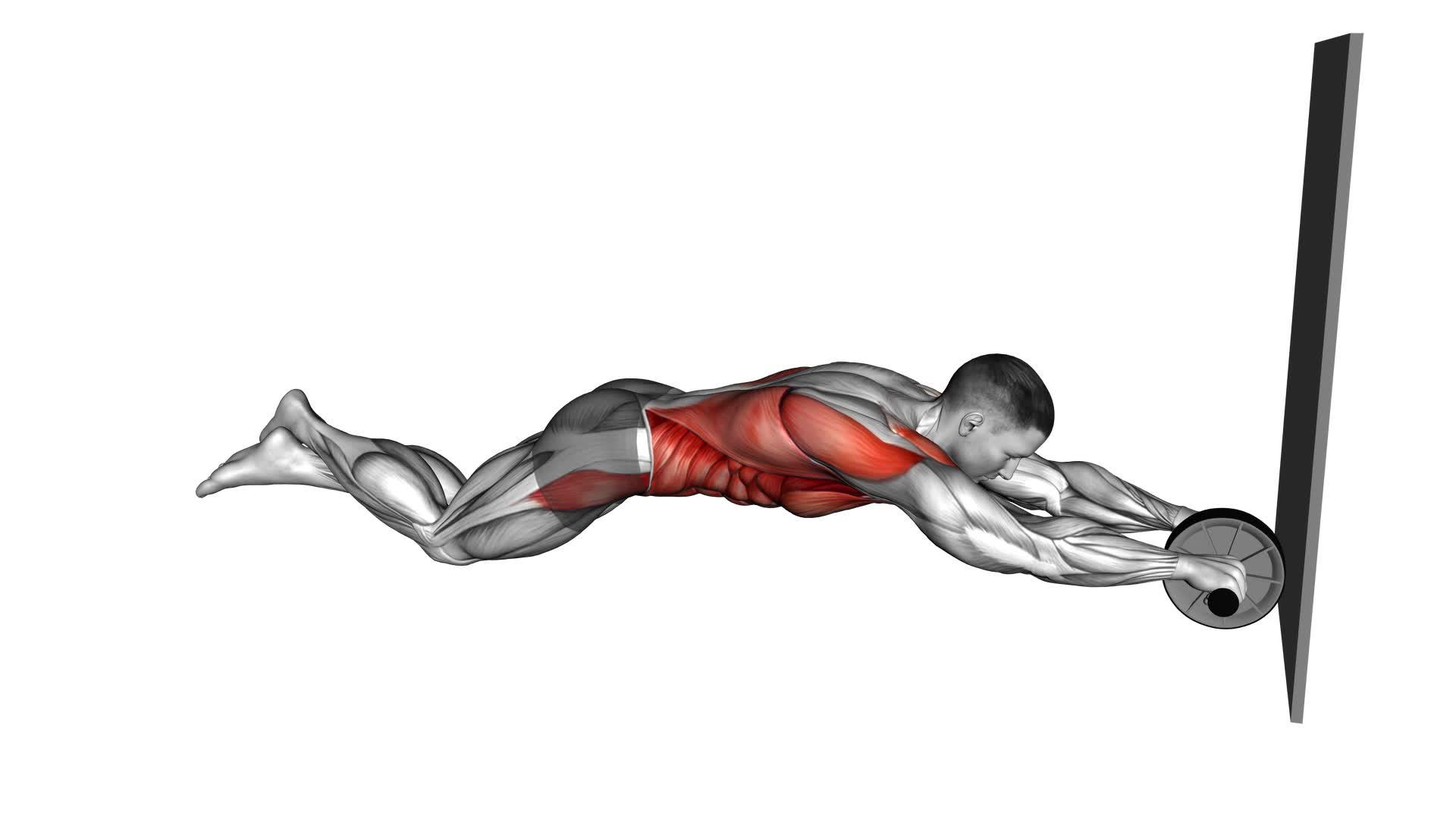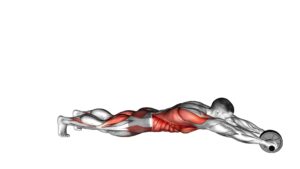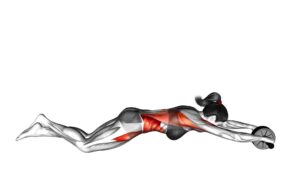Wheel Rollout With Wall Support (Male) – Video Exercise Guide & Tips

Are you looking to strengthen your core and improve your stability? Look no further than the Wheel Rollout With Wall Support.
Watch This Exercise Video
This exercise is perfect for men who want to take their fitness to the next level. With just a few simple steps, you can engage your abs, shoulders, and back muscles in a challenging and effective workout.
In this video exercise guide, we'll show you the proper form and technique, as well as provide tips for beginners and advanced variations.
Let's get rolling!
Key Takeaways
- Wheel rollout with wall support improves core strength and stability training.
- The exercise strengthens and stabilizes the entire midsection.
- Proper form and technique, such as avoiding arching the back and focusing on using core muscles, are important for performing the exercise effectively.
- Modifications and progression, such as using a chair for assistance and increasing sets and reps as strength improves, can be made to suit individual needs and abilities.
Benefits of Wheel Rollout With Wall Support
You should consistently practice the Wheel Rollout With Wall Support to experience its numerous benefits. This exercise is highly effective for improving core strength and stability training. By engaging your core muscles, including the abs, obliques, and lower back, the Wheel Rollout With Wall Support helps to strengthen and stabilize your entire midsection. This leads to improved posture and balance, reducing the risk of injuries and enhancing overall athletic performance.
The Wheel Rollout With Wall Support also targets the muscles in your shoulders, arms, and chest. As you roll the wheel out, these muscles are engaged to support your body weight and maintain control. This not only increases upper body strength but also improves shoulder stability and mobility.
In addition, the Wheel Rollout With Wall Support challenges your coordination and proprioception, which is your body's ability to sense its position in space. By practicing this exercise regularly, you can enhance your body awareness and control, leading to better movement patterns and overall functional fitness.
Equipment Needed for the Exercise
To perform the Wheel Rollout With Wall Support exercise, there are a few essential pieces of equipment you'll need.
The most important is an ab wheel, which is a small, wheel-shaped device with handles on either side.
Additionally, a wall or sturdy surface to support your feet is necessary to maintain stability and proper form.
If you don't have an ab wheel, you can use alternatives like a towel or a barbell with plates on either end.
Essential Exercise Equipment
What equipment is necessary for the Wheel Rollout With Wall Support exercise?
Here are four essential exercise equipment options that are affordable and can help you achieve your fitness goals:
- Ab wheel: This compact and versatile equipment strengthens your core, shoulders, and arms, making it perfect for the Wheel Rollout With Wall Support exercise.
- Resistance bands: These portable bands provide adjustable resistance for a variety of exercises, including the Wheel Rollout With Wall Support. They help target and tone different muscle groups.
- Yoga mat: A non-slip yoga mat provides a comfortable and stable surface for performing the exercise. It also protects your knees and elbows from discomfort or injury.
- Wall support: Using a sturdy wall as support adds stability and safety to the exercise, allowing you to focus on engaging your core muscles effectively.
These affordable exercise equipment options will help you get the most out of the Wheel Rollout With Wall Support exercise.
Now, let's explore alternatives to expensive gear.
Alternatives to Expensive Gear
For the Wheel Rollout With Wall Support exercise, you can opt for cost-effective alternatives to expensive gear. Instead of purchasing a pricey exercise wheel, you can make your own DIY equipment using simple household items.
One option is to use a sturdy skateboard with wheels. Attach a handlebar or a broomstick to the skateboard deck, and you have a makeshift exercise wheel.
Another cost-effective alternative is to use a furniture slider. Place the slider on a smooth surface, like a hardwood floor, and hold onto the slider handles while performing the wheel rollout motion.
These DIY options provide a budget-friendly solution for those who want to incorporate the Wheel Rollout With Wall Support exercise into their fitness routine without breaking the bank.
Proper Form and Technique
You need to maintain proper form and technique while performing the Wheel Rollout With Wall Support exercise. Proper form is crucial to ensure that you engage the correct muscles and avoid any potential injuries. Here are some common mistakes and misconceptions to be aware of:
- Arching your back: One common mistake is arching your back as you extend your arms forward. This not only takes away from the effectiveness of the exercise but also puts unnecessary strain on your lower back. Keep your core engaged and your back flat throughout the movement.
- Using momentum: Another mistake is relying on momentum to roll the wheel out and back. This takes away from the challenge and reduces the effectiveness of the exercise. Instead, focus on using your core muscles to control the movement and maintain a slow and controlled pace.
- Holding your breath: Many people tend to hold their breath while performing this exercise, which can lead to increased tension in the body. Remember to breathe consistently and naturally throughout the movement to optimize oxygen flow and maintain proper form.
- Neglecting proper hand placement: It's important to position your hands properly on the wheel handles. Place your hands shoulder-width apart, fingers pointing forward, and maintain a tight grip throughout the movement. This will provide stability and prevent any slipping or loss of control.
Modifications for Beginners or Those With Limited Mobility
If you're a beginner or have limited mobility, there are modifications you can make to the Wheel Rollout With Wall Support exercise to suit your needs. Adapting the exercise for individuals with disabilities is important to ensure that everyone can benefit from this workout.
One modification you can try is using a chair for assistance. Instead of starting from a kneeling position, you can sit on the chair and place your hands on the wheel. Push the wheel forward as far as you can while maintaining control and then slowly roll it back towards you. This chair-assisted modification allows you to still engage your core muscles and work on your stability, but with less strain on your body.
It's important to listen to your body and only go as far as you feel comfortable. Remember to engage your core and maintain proper form throughout the exercise. As you become more comfortable and gain strength, you can gradually increase the difficulty by decreasing the assistance from the chair.
Now that you know how to modify the Wheel Rollout With Wall Support exercise, let's move on to the recommended sets and reps for optimal results.
Recommended Sets and Reps for Optimal Results
To achieve optimal results, incorporate the following recommended sets and reps into your Wheel Rollout With Wall Support exercise routine:
- Start with 2 sets of 8-10 reps: Begin by performing 2 sets of 8-10 repetitions of the Wheel Rollout With Wall Support exercise. This will help you build strength and stability in your core muscles.
- Increase to 3 sets of 12-15 reps: As you become more comfortable with the exercise, gradually increase the number of sets and repetitions. Aim for 3 sets of 12-15 reps to further challenge your muscles and improve your overall fitness level.
- Add resistance for advanced training: Once you have mastered the basic form of the Wheel Rollout With Wall Support, you can make the exercise more challenging by adding resistance. This can be done by placing a weight plate on top of the wheel or using a resistance band for added resistance.
- Take rest days between workouts: It's important to give your muscles time to recover and adapt to the demands of the exercise. Take rest days between workouts to allow for proper recovery and maximize your results.
By following these recommended sets and reps, you can effectively strengthen your core muscles and achieve optimal results with the Wheel Rollout With Wall Support exercise.
Recommended modifications:
- If you're a beginner or have limited mobility, you can start by performing the exercise with your knees on the ground instead of in a full plank position.
- To prevent common mistakes, make sure to maintain proper form throughout the exercise. Keep your core engaged, avoid arching your back, and roll the wheel out and in using controlled movements.
Tips for Progression and Advanced Variations
To progress in the wheel rollout exercise and challenge yourself with advanced variations, there are a few key points to keep in mind.
First, if you're a beginner, it's important to modify the exercise by starting with shorter wheel rollouts and gradually increasing the range of motion as you build strength and stability.
For those looking for a greater challenge, advanced variations like single-arm rollouts or elevated rollouts can provide an extra level of difficulty to further engage your core muscles.
Modifying Exercise for Beginners
You can modify the Wheel Rollout exercise to make it easier for beginners by using a wall support for added stability. This modification allows you to build strength gradually and reduce the risk of injury.
Here are 4 tips to help you modify the exercise effectively:
- Start with a shorter range of motion: Limit how far you roll out to decrease the difficulty and increase control.
- Use your knees as a pivot point: Instead of starting from a full plank position, begin with your knees on the ground and roll out from there.
- Increase the angle of the wheel: By placing the wheel closer to the wall, you can create a shallower angle, making the exercise more manageable.
- Focus on proper form and control: Slowly extend and contract your arms while engaging your core muscles to maintain stability throughout the movement.
Challenging Advanced Variations
As you progress in your training, there are various challenging advanced variations of the Wheel Rollout exercise that can take your strength and stability to the next level. These advanced progressions will continue to challenge your core muscles and improve your overall body control.
One advanced variation is the Single Leg Wheel Rollout, where you perform the exercise with only one leg extended, increasing the demand on your core and stability muscles.
Another option is the Eccentric Wheel Rollout, where you focus on the lowering phase of the movement, slowly extending your arms while maintaining control.
Additionally, you can incorporate muscle activation techniques such as using resistance bands or performing the exercise on an unstable surface like a stability ball.
These advanced variations will push your limits and help you continue to make progress in your fitness journey.
Frequently Asked Questions
How Long Should I Hold the Wheel Rollout Position?
To progress in the wheel rollout exercise, aim to hold the position for a longer duration over time. Start with holding it for 5-10 seconds and gradually increase as you build strength and stability.
Holding the position engages your core muscles, improves core strength, and enhances stability. This exercise also targets your shoulders, chest, and back.
Remember to maintain proper form and listen to your body to avoid overexertion and injury.
Can I Do the Wheel Rollout Exercise Without a Wall Support?
Yes, you can definitely do the wheel rollout exercise without a wall support. Doing the exercise without the wall support can provide you with alternative variations that can challenge your core muscles even more.
Are There Any Specific Muscles Targeted by the Wheel Rollout Exercise?
When doing the wheel rollout exercise, you target specific muscle groups in your body. This exercise primarily works your core muscles, including your abs, obliques, and lower back. It also engages your shoulders, chest, and arms as stabilizers.
The benefits of the wheel rollout include strengthening your core, improving stability and balance, and enhancing overall body strength. So, if you're looking to work those specific muscle groups, the wheel rollout is a great exercise to try.
Can I Incorporate the Wheel Rollout Exercise Into My Existing Workout Routine?
You can definitely incorporate the wheel rollout exercise into your existing workout routine. It has numerous benefits for your full body workout, such as improving core strength, stability, and overall muscular endurance.
To modify or progress the exercise, you can adjust the distance between the wheel and the wall for added difficulty or use an ab wheel with handles for better grip.
Make sure to maintain proper form and gradually increase intensity to avoid injury.
What Are Some Common Mistakes to Avoid While Performing the Wheel Rollout Exercise?
When performing the wheel rollout exercise, it's important to focus on proper form and breathing technique. Avoid common mistakes like arching your back or letting your hips sag.
Keep your core engaged and maintain a straight line from your head to your knees. Remember to breathe out as you roll forward and breathe in as you return to the starting position.
Conclusion
In conclusion, the wheel rollout with wall support is an effective exercise for strengthening the core and improving overall stability.
By following proper form and technique, beginners and those with limited mobility can modify the exercise to suit their needs.
Gradually increasing sets and reps will yield optimal results over time.
Additionally, incorporating progression and advanced variations will challenge the body and continue to promote strength gains.

Author
Years ago, the spark of my life’s passion ignited in my mind the moment I stepped into the local gym for the first time. The inaugural bead of perspiration, the initial endeavor, the very first surge of endorphins, and a sense of pride that washed over me post-workout marked the beginning of my deep-seated interest in strength sports, fitness, and sports nutrition. This very curiosity blossomed rapidly into a profound fascination, propelling me to earn a Master’s degree in Physical Education from the Academy of Physical Education in Krakow, followed by a Sports Manager diploma from the Jagiellonian University. My journey of growth led me to gain more specialized qualifications, such as being a certified personal trainer with a focus on sports dietetics, a lifeguard, and an instructor for wellness and corrective gymnastics. Theoretical knowledge paired seamlessly with practical experience, reinforcing my belief that the transformation of individuals under my guidance was also a reflection of my personal growth. This belief holds true even today. Each day, I strive to push the boundaries and explore new realms. These realms gently elevate me to greater heights. The unique combination of passion for my field and the continuous quest for growth fuels my drive to break new ground.







